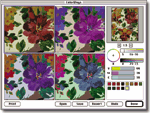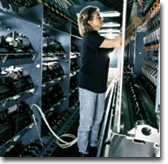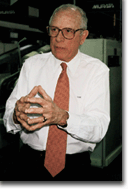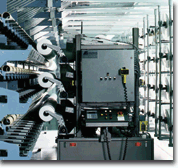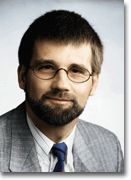
The beginning of this year has brought with it a new force in the weaving industry. The
merger agreement between Sulzer Ruti and Nuovo Pignone was finalized, forming the new Sulzer
Textil. This move creates the largest supplier of weaving machines in the world.The industry is
waiting to see how this consolidation will affect these two companies and their product lines.
Nuovo Pignones line of rapier machines will make Sulzer Textil an industry powerhouse, covering
major sectors of the industry under one corporate umbrella.Philip Mosimann, president of Sulzer
Textil, recently sat down with ATI to discuss the merger, the future of weaving technology, new
markets and the upcoming ITMA in Paris.ATI: What are Sulzer Rutis most important markets How do you
separate markets by different needsPhilip Mosimann: From a geographical viewpoint, Europe remains a
strong market for us. Within Europe there are countries that are more important than others in
terms of the size of the business, such as Germany, Italy, France and the United Kingdom.Then there
are the American continents, where the United States, Mexico and Brazil, going by size, are the
most important ones to us.Asia also is a big market. Currently, for obvious reasons, that market is
very soft.In Europe, rapier looms are very strong because they produce articles following fashion.
In the United States, air jet is a lot stronger than any other technology. We are in a position to
adapt our sales organization to sell the type of technology that the customer needs.ATI: What role
is the North American market playing in Sulzer Rutis product and market strategyPM: An important
one. We have reviewed our product market strategy and have definitely decided to give the American
market a strong push, mainly with our air-jet machines, but also in special applications with
projectile. But projectile is more of a niche application in the U.S. market.For specific
applications, our rapier machine is also sold in the United States. A new development is that
American companies order looms and then they install them in Mexico, but we also get direct orders
from Mexico. ATI: Nuovo Pignones rapier loom has an excellent reputation. Was that one of the
reasons for Sulzers recent purchase of the companyPM: Definitely. The weaving machine industry is
really ahead of a consolidation. If you look at it, $2.1 billion is roughly the market size. There
are about nine major players, so each one of them has about $200 to 250 million, and for a global
business that is very small.We want to lead the field. We were looking for the most complementary
partner, with regard to products and customer markets. If you look at Nuovo Pignones weaving
machinery division, they have a good rapier loom, and they are strong in Asia because they have a
more standard loom at a lower price. Nuovo Pignone also has as additional customer base. It works
out well for us.ATI: Will Nuovo Pignones strong position in Asia have any impact on your
relationship with Toyoda Automatic LoomsPM: In the long term, there is always an impact. The
question is how big it will be. We will definitely continue with Toyoda as in the past. Our
relationship wont change. And, we continue to push our L5200 machine, which has a good position in
the market and is getting a positive response in the United States. Last year was successful,
better than 97. Our air-jet sales are increasing this year compared to last year, and in that
respect, Toyoda Automatic Loom Works remains our partner as before.ATI: How has the weaving machine
business changed over the last five to 10 years, and how has Sulzer Ruti adaptedPM: The good old
days were in the early 90s or late 80s, when there were some 70,000 looms a year being produced.
Now we are seeing a downturn to nearly 45,000 looms. 1997 was up quite a big jump, but it was in
water jet. We saw a lot of this in Asia, where there were 17,000 water-jet looms sold in 1997. The
water-jet boom collapsed in the first half of 1998. Water jet is a totally different business, one
we are not a part of. As big as this jump was, the fallout in 1998 was equally big and caused
serious headaches to my colleagues in Japan who manufacture those looms. Water jet is only used
with synthetics, and this had an impact on the 1997 increase, along with some huge orders being
placed in Indonesia, China and Korea.Then came the Asian crisis, and as suddenly as this wave went
up, it went down. Our assessment is for an average of 45,000 looms per year, plus or minus 5,000.
That corresponds to the swings and the volatility of the textile industry. So, in a bad year like
1998, it will probably be in the 40,000 range, and in a good year it could be close to 50,000. In
1997, there were 53,000 looms sold under these statistics.ATI: In the future, do you plan to focus
your production on a specific type of loom or series of loomsPM: Yes. I think given the market
situations. With our merger with Nuovo Pignone, we will give rapier special attention.Projectile
looms have had a huge success story. More projectile machines are sold worldwide, and we are going
to sell to those customers who can take advantage of that type of technology. No one weaving type
will get 60 percent of the market, so there will always be a balance. But on average, over several
years, we expect projectile to remain strong.ATI: Which countries can best take better advantage of
the projectile loomPM: Countries with high energy costs work best. Projectile looms have, by far,
the lowest energy costs. For countries that dont need multi-color applications, such as eight or 10
colors, projectile is very good, and when someone needs a more universal machine than an air
jet.Two countries in the Americas with large concentrations of projectile looms are Brazil and
Mexico. We see good applications in Germany for projectile. In Europe, there is mainly rapier and
projectile, depending on the type of style being manufactured. ATI: What is the status of the
M8300 Multiphase weaving machine, and where do you have commercial installations Will there be a
U.S. installationPM: We have completed development work for the standard applications, and we are
in the controlled-market-introduction phase. That means we have a limited number of customers where
we sell these looms in a controlled manner. We need mills and customers who really fine tune their
logistics, to be able to handle the high-speed and achieve the maximum benefits.For example, if the
company does not have an optimized warp change, or if their machine stands there for a long time,
every minute you lose on the M8300 is a greater production loss than the same minute on a
projectile, rapier or air-jet machine. We have installations in France, Germany and Italy. We plan
to have one small installation in the United States this year. Right now, we cant disclose the
location. In Northern Italy, we have an installation at Standard Tela and the controlled market
introduction is in the area of fabrics that go from six to 30 threads per centimeter in the warp
and filling for standard applications. ATI: Looking ahead, what kind of market share do you see for
each of the weaving machine technologies (multiphase, air jet, rapier, projectile) in terms of
machines purchasedPM: We see rapier technology, on a global basis, to be in a range of 40 to 50
percent of all looms sold. We see air jet to be in the range of 20 to 25 percent, and water jet on
a global scale is in the range of 15 percent, with some big swings like 1997. That is important.
From year to year it can change quite dramatically.ATI: What is the prospect for Sulzer Ruti looms
in Latin America for the next five years Which Latin American countries are your best clientsPM:
Brazil and Mexico are by far the largest. That doesnt mean that we dont have any sales and activity
in the other countries, but these are the dominant countries. The M8300 loom has big potential in
Brazil and Mexico. They have large production of standard fabric applications. We see big potential
for these two countries in the future.ATI: What has been the growth rate of Sulzer Ruti loom sales
in Latin America over the past few years Which of your looms are the most popular and whyPM: With
the exception of a very lousy year in 1996, we are in the order of some 500 to 600 looms.
Projectile weaving is very strong in Latin America overall. Our rapier loom, for example, is too
focused on high-end applications. We basically have few customers and sales of our rapier in this
area, with the exception of American-based companies that are starting to build factories in
Mexico.With Nuovo Pignone, that can change as well, because of the type of looms. We also sell in
Asia standard and more simple. There will be more potential in Mexico and Latin America for us in
the future.ATI: What has been the response of Latin American customers to the P-Lean loomPM: It has
been very well accepted in Brazil. Mexico has some small installations. Brazil is a strong outlet,
and the customers always do battle for productivity and flexibility. P-Lean is more productive and
simpler, but in the end has somewhat lower flexibility than the normal P7100 or P7200.ATI: Have you
had good response from Latin American customers to your new computerized training programs PM: They
are interested. Some are looking into it and some customers have bought it. It is still a slow
start. Some workers in Latin American mills arent as computer savvy. Its a matter of time.Mill
management has seen the potential for savings of training costs, but it has not really gotten off
the ground as we would like. I think it will take another year or two and then were there.ATI: How
have your sales to Mexico been affected by NAFTAPM: As far as Mexico goes, you see some of our
strategy in our air-jet push. It not only goes to the United States, but it also goes to Mexico. In
1994 we were below 100, in 97 we were above 250 and last year will be in the same area. Theres been
positive growth in Mexico.ATI: Will Sulzer Ruti and Nuovo Pignone have separate booths at ITMA, and
what can you tell us about your new releases at the upcoming showPM: We will have one booth.
Through an arrangement with CEMATEX, we have neighboring booths so we will be able to have one
booth under Sulzer Textil.As far as new releases, we cant say anything in precise terms, of course.
I think the developments, not only our own but the industry in general, basically go in three
directions.One is an increase in performance. Another is an increase in textile applications
machine flexibility. The third is ease of operation simple, repeatable machine adjustments. We are
active in these areas. This includes style changes. For example, you may have the same warp but you
might want to change the density of filling, or things like that.Also, demand machine interfaces
will be changed in a way to go to more modern technologies. There wont be such a sensation like
ITMA 95, and definitely not the revolution we experienced with the M8300, which was completely
new.ATI: The Swiss textile machinery will have a slightly smaller space at ITMA Paris than they had
in Milan in 95. If you combine your booth and Nuovo Pignones, wont that mean youll have twice as
much spacePM: No, it wont be that much. If you have one booth for Sulzer Ruti and one booth for
Nuovo Pignone, it is obvious you need less space.So on the Swiss booth space, you have an increase
and on the Italian booth space you have a decrease. I think that is the first synergy we are
realizing, we dont need as much. ATI: Will the recent troubles in world markets affect ITMA
attendancePM: I think the audience will be good. Suppliers with exhibitions are larger than they
were last time, and thats a good sign.On the other hand, ITMA and all exhibitions have lost a
little bit of that paradise we had 10 years ago. Customers dont hold their orders for ITMA anymore.
For suppliers, if we have a new loom or invention, why should customers wait for a year or so
before they purchase it The Russian and Asian situations are also going to slow things down.ATI:
Originally, plans called for a loss of 200 jobs in Switzerland. Does that mean there will be an
increase in jobs in Italy or will you be able to manage with fewer peoplePM: There will be a slight
increase in Italy. If you look at the Italian businesses, they are organizing with a lot of
sub-suppliers. That means that if sales go up, we dont have to increase our number of people. But
there definitely will be more work in the area. So maybe there will be more jobs in the supplier
network around the company. ATI: Are you planning to send anybody from your Swiss operation to
ItalyPM: We will send one person, who will be the general manager of this company in Italy. But
thats all. We really tried to integrate the management team of Nuovo Pignone into our organization
in order to profit the most from their knowledge and their experience in the rapier business. That
means the responsibility for the combined rapier business will be in Italy. Because they are
producing a lot more looms than we do on Sulzer Rutis side, we want to have it in one location not
two. However, the global logistic center for spare parts will be run out of Switzerland. Therefore,
all spare parts, including those for Nuovo Pignone looms, will continue to be available 365 days a
year, and orders are done automatically. All orders leave the factory within 24 hours of being
received. We fly spare parts four times a week from Switzerland to the United States.ATI: When you
introduced the M8300 three-and-a-half years ago, you said it did not require a standard structural
base. It this still true in the practical applicationPM: Its absolutely true. You take that
machine, place it on the floor, and you dont even have to fix it to the floor.There is a simple
reason for this. The loom has the fewest vibrations because everything is rotating. You dont have
oscillating masses. If you look at a rapier machine, for example, you have the rapiers going back
and forth, so you move masses in an oscillating way.None of this exists on the M8300. You place it
on the floor and thats it. Its a big advantage in terms of layout, flexibility and building
construction costs. All the machines we have in our plants that have more than a billion picks were
only placed on the floor, not even screwed on.
February 1999


